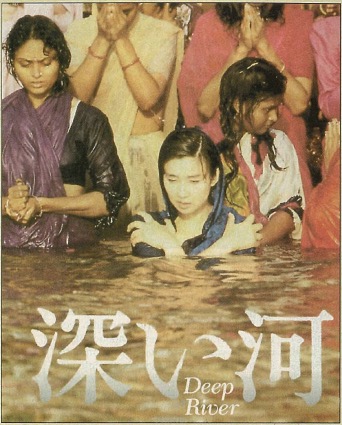WITH JYOTHI VENKATESH, Mumbai
A bus of Japanese tourists bounces east, sightseeing from Delhi toward Banaras and the Ganga. “Oh, so beautiful,” one man says, “This is the first time I am seeing people and animals living together. In the past, in Japan, they lived like this, too.” Another tourist excitedly clicks photos out the window of fertile earth, dusty cows and industrious villagers. His bride complains they should have gone to Europe. Swiftly the lens of director Kei Kumai focuses in on three unusual souls on the bus quietly engrossed in a more introspective mission–to win peace and blessings from the holy river Ganga. Their stories then start to unfold in the film.
“Deep River” won acclaim at New Delhi’s International Film Festival and the Ecumenical Award at the World Film Festival in Montreal. It caught Indian film critics’ attention because it is about the Japanese’ finding their “lost Indian roots.” Explains Kumai, “We Japanese are very much influenced by Indian culture and, from the point of view of a Japanese, India is our motherland.” Many Japanese travel yearly to India (65,000 in 1996), often to visit Buddhist holy sites. Japan is the largest donor nation to India, and, after the economic reform, India’s fifth largest investor.
“Deep River” is based upon Shusaku Endo’s award-winning novel of the same name. It is an exploration into the meaning of India for four individuals. One is a World War II veteran (played by the legendary Toshiro Mifune), desperate to quell horrible war memories experienced on India’s Burmese border. The second is a businessman looking for his wife who died and who, he is told, has been reborn near Banaras. He is torn by the guilt that all during their marriage, while she loved and served him with extraordinary selflessness, he gave her very little affection. The third and central character is Mitsuko (Kumiko Akiyoshi, Japan’s top film actress), a divorcée, lost at midlife and looking for meaning.
The fourth is Otsu, a spiritually reflective man whom Kumiko seduced on a dare from her friends and then cruelly dumped. He was a Catholic–rare in Japan–who went to a seminary in France, then to a monastery in Israel. Finally finding no comfortable place in the Western expression of Christianity, he came to Banaras, joined an ashram, and took up work at the cremation grounds. “Europeans consider God and man to be mutually opposed but, being Japanese, I cannot ignore the great vital energy of nature,” Otsu explains to Mitsuko. “I believe God exists within man, while embracing man, trees and flowers, the Great Life Force. And the most important thing is love.”
By the movie’s end, each has found some form of resolution: the veteran, a difficult realization of the honor of men within the horrors of war; the businessman, the futility of finding his wife; Mitsuko, absolution for her self-centered life by bathing in the Ganga; and Otsu, death in his chosen service.
The US$4.3 million film is elegantly made, every scene is a work of art. But its subtitles and measured pace (read “slow”) will not keep everyone’s attention. A few scenes are too racy for children. It was seen by 135,000 people in Japan, and has yet to turn a profit. Copies won’t be found at the corner video store, but can be located through film specialists.
Much of the movie was shot in Banaras by a cast and crew of 50 Japanese and 70 Indians. After the production, director Kumai said, “I think our staff each encountered the Ganga just like the movie’s characters. The holy power of the Ganga revealed Herself through them. We received awareness of the spiritual world, so forgotten in today’s consumerist society of Japan. Since World War II, we have developed materially, but are we happy? My film shows how these characters come to find in India what they could not find at home. They ask, ‘What is the most important treasure in one’s life–material pleasure or spiritual pleasure and contentment as is found in the Hindu religion?'”
With Jyothi Venkatesh
Mumbai


